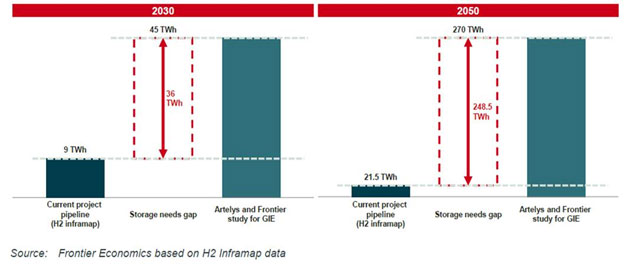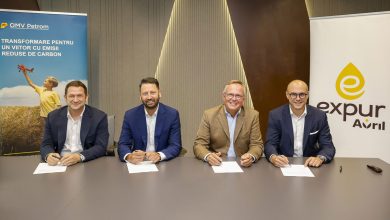Talking to Experts: Boyana Achovski, Secretary General of GIE
UHS Needs to Facilitate the Transition Towards a Decarbonized Energy System
We are talking to Boyana Achovski – Secretary General of GIE, about actions and measures to foster a secure supply of energy produced as sustainably as possible and at affordable prices.
Gas Infrastructure Europe (GIE) is the association representing the interests of European gas infrastructure operators. GIE members are active in transmission, storage and import terminals. Its members work and innovate with natural, low-carbon, renewable gases, including hydrogen and biomethane. Gathering 68 industry entities from 25 European countries, GIE perfectly embodies the multiple transitional decarbonisation pathways of the EU regions. The association’s vision is that by 2050, the gas infrastructure will be the backbone of the new innovative energy system, allowing European citizens and industries to benefit from a secure, integrated and climate-neutral energy supply.
Dear Boyana, how would you describe a well-functioning energy market and what are GIE’s solutions to pair the security of supply in Europe with decarbonization of the economy?
Boyana Achovski: A well-functioning energy market is characterized by a robust infrastructure network, efficient regulatory frameworks, and diversification of supply sources. The European gas infrastructure, overseen by Gas Infrastructure Europe (GIE), exemplifies these qualities. GIE manages critical elements such as gas pipelines, underground storage, and LNG terminals, facilitating 25% of the EU’s primary energy consumption and connecting Europe to global markets. This infrastructure provides options for diversifying supply routes and sources, which is crucial for enhancing energy security. Moreover, it offers multiple pathways for decarbonization, recognizing the varying starting points of different nations.
Looking ahead, GIE is committed to supporting energy consumers, including energy-intensive industries, on their way towards decarbonisation. This involves meeting ambitious targets, such as producing 10 million tons of hydrogen in the EU by 2030 and importing an additional 10 million tons. To support these efforts, GIE has collaborated with other entities to develop tools like the h2 infra map, which showcases gas infrastructure development plans up to 2050, including 450 projects. By adapting infrastructure to industry needs and fostering relationships across the value chain, GIE aims to tailor solutions to different regions. This includes understanding decarbonization paths through comprehensive reports and studies, which outline energy transition status, emissions data, and strategies of EU countries. As gas infrastructure transforms, it remains integral to supply security and emission reduction efforts, driving the shift towards a more sustainable energy future.
The newest sustainable approaches for decarbonization of the energy sector focus on smart strategies, innovative technologies and concepts, digital tools, and available mechanisms. How does GIE see the decarbonization of the gas infrastructure with renewable and low-carbon gases?
Boyana Achovski: Europe’s gas infrastructure is evolving to support decarbonization goals while ensuring security of supply through innovation, investment, and regulatory support. With extensive membership from 25 countries, GIE plays a crucial role in connecting Europe’s energy sector with broader EU strategies. This includes facilitating ongoing dialogue with members and providing ‘transparency’ tools for informed decision-making. In the short term, efforts focus on finding alternative gas sources, securing gas stocks, and supporting biomethane production. In the medium term (2023-2025), investments are needed to amend and expand gas infrastructure for decarbonization and accelerate hydrogen production.
Beyond 2025, steps include fostering renewables and further expanding infrastructure for renewable and low-carbon gases. Among the solutions:
- Renewable Gas: Increasing production and utilization of renewable gases like biomethane and hydrogen. Biomethane is already being integrated into the infrastructure, with plans for further expansion. Meanwhile, hydrogen projects are emerging all across Europe.
- Energy Storage: Enhancing flexibility and reliability through energy storage technologies like power-to-gas and underground storage for hydrogen. These measures support the integration of renewable and low-carbon gases into the infrastructure.
- Diversification and Interconnection: Strengthening interconnections and diversifying gas supply sources to enhance security. This involves increasing LNG imports, expanding infrastructure, and ensuring efficient interconnectivity across regions.
- Regulatory Support: Implementing supportive policies and regulatory frameworks to incentivize investments in low-carbon infrastructure. This includes certification schemes for renewable gases and mandates for emissions reductions.
- Hydrogen Transition: Accelerating the development of hydrogen infrastructure, including repurposing existing gas infrastructure, and building new hydrogen pipelines. The European Hydrogen Backbone aims to establish a comprehensive hydrogen network by 2050.
GIE just announced an exclusive presentation on underground hydrogen storage needs in the European energy system and the hydrogen storage targets for 2030 and 2050. Could you please share some conclusions/implications of the study with us and maybe some directions for future research?
Boyana Achovski: GIE has coordinated a study with 17 storage operators on underground hydrogen storage (UHS) needs by 2030 and 2050 with Frontier Economics & Artelys. One thing is clear: it is imperative and urgent to address UHS needs to facilitate the transition towards a decarbonized energy system.
There is a massive gap between the EU UHS needs and current UHS projects planned by 2030 to comply with REPowerEU ambition. This gap will be even higher by 2050.
In line with the study, GIE recommends:
- An explicit EU-wide target and ambition for UHS capacity at (temporal) checkpoints, including a target of 45 TWh in 2030 to enshrine and recognise the values of storage and associated capacity needs in official EU policy (similar to REPowerEU).
- Address administrative and complex approval processes to facilitate project implementation.
- Introduce targeted and tailored support mechanisms for UHS projects with multiple objectives.
- Monitor the market via the regular (e.g. annual) assessment of a range of EU-wide KPIs on both project pipeline and planned/commissioned capacity and UHS needs, fostering the agility to react to possible changes in market needs and the wider system environment.
GIE has an increasing focus on CCUS technologies. From your viewpoint, how can CCUS decarbonize the energy-intensive sectors that are hard to decarbonize while creating a circular carbon economy?
Boyana Achovski: Gas infrastructure, through its role in Carbon Capture, Utilization, and Storage (CCUS), offers a pivotal solution for decarbonizing intensive industries. With our pipelines and storage facilities efficiently, we will be able to transport, and store captured CO2 emissions from industrial processes. This integration allows industries to reduce their carbon footprint while leveraging existing infrastructure, minimizing investment costs. This solution provides a scalable and cost-effective pathway for intensive industries to decarbonize and transition to a low-carbon future.
On February 6th, 2024, the European Commission presented its Industrial Carbon Management/CCUS Strategy, which will lay the ground for subsequent legislative initiatives. Gas infrastructure operators will play a key role in supporting the development of CCUS in Europe; they are already working on it. In GIE, we have increased the resources on the topic by creating a dedicated area. We will accompany the process around this strategy, engage with policymakers, provide feedback on the proposal, and build alliances with other associations and stakeholders, where appropriate.
You are a powerful voice as a woman leader in the energy sector. What are your recommendations for women in Romania to score success in their environmental, social, and professional endeavours?
Boyana Achovski: “The only limit to the height of your achievements is the reach of your dreams and your willingness to work hard for them.” I think this sentence from Michelle Obama says it all.
What is key? Bravery, determination, and discipline. Nurture your confidence through self-investment and remember to surround yourself with a supportive network for continued growth. I will always be thankful for the inspiring mentors and dedicated team members who have played a significant role in today’s success.
Besides, your journey doesn’t have to be linear. With a background in international relations, I initially aspired to evolve in politics and even diplomacy. Energy was not part of the picture. This was until Bulgartransgaz, the national operator of the Bulgarian gas infrastructure, offered me a managerial opportunity. I had to lead a team of experts, to drive international investments to leverage the development of our gas network. This was thirteen years ago; I am now the Secretary General of the European voice of the gas infrastructure operators.
While it was an honour to close 2023 with the award for the Most Influential Woman Leader in Energy of Central and Eastern Europe, it was an extra motivational boost to start 2024 with the recognition of being a top EU leader to follow for energy matters. May it inspire others to go for what they want.
Boyana Achovski has been the Secretary-General of GIE since 2016.
Boyana started her European affairs career in the European Parliament in Brussels and led the Analysis and International Operations Division in Bulgartransgaz, later joining GIE in 2012 as the first secondment of the Bulgarian gas infrastructure operator to the European association. She also chaired the Steering Committee of GasNaturally twice, the coalition of Europe’s whole gas value chain.
Boyana graduated with a degree in International Economic Affairs, specializing in International Finance. She holds a master’s degree in finance and management of international Associations from the Solvay Brussels School. She also obtained a certificate in women’s leadership from the University of Oxford.
In 2023, Boyana won the award of the most influential Energy Women Leader of Central & Eastern Europe. Committed to advocating for greater gender equality and diversity in the energy transition, she is a Member of the Board of WiRA (Women in Renewables Alliance), a global network of professional women in the renewable energy sector. She is part of WoNY, an alliance promoting gender diversity in the CEE-SEE region.








